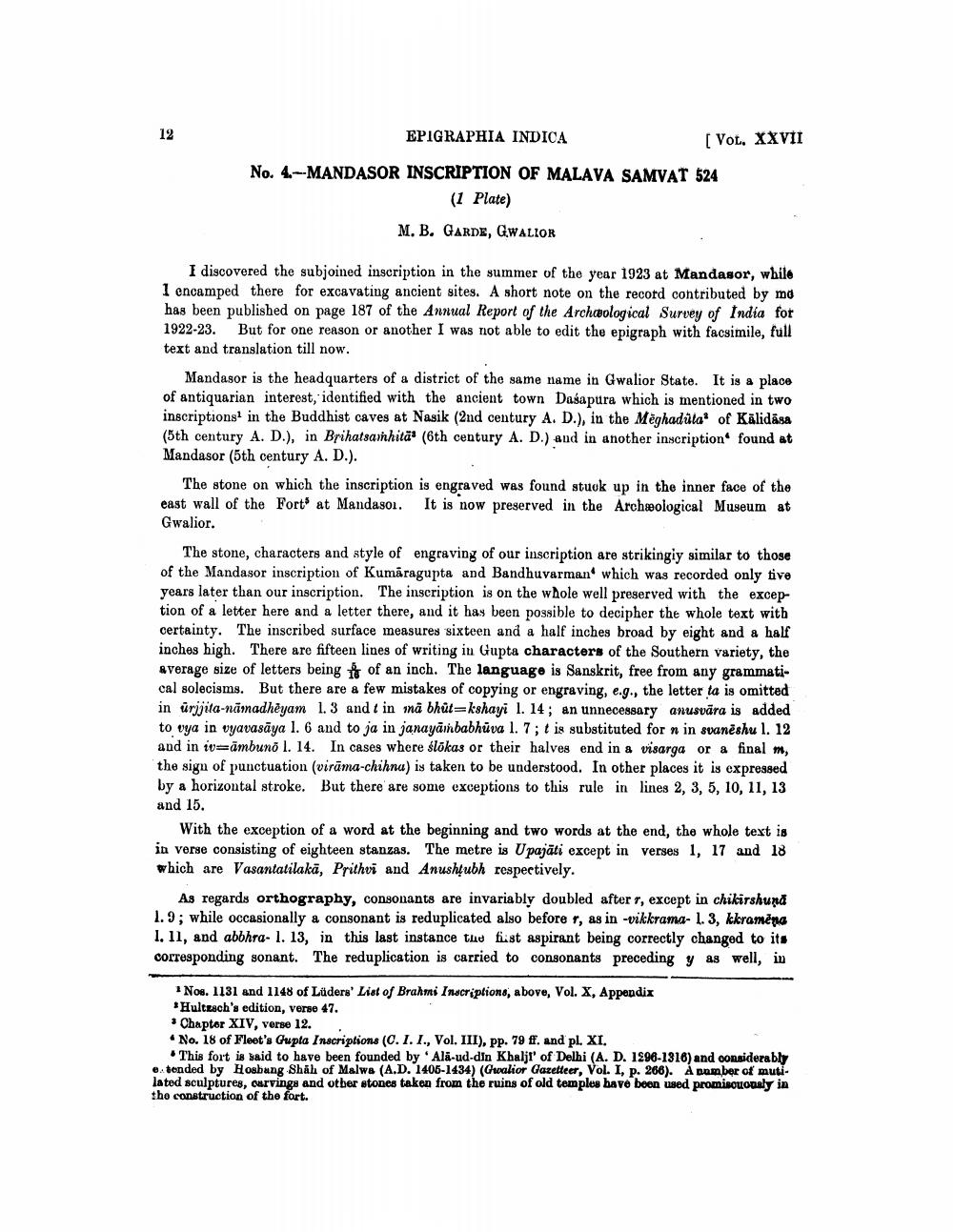________________
EPIGRAPHIA INDICA
[Vot. XXVII No. 4-MANDASOR INSCRIPTION OF MALAVA SAMVAT 524
(1 Plate) M. B. GARDE, Gwalior
I discovered the subjoined inscription in the summer of the year 1923 at Mandasor, while 1 encamped there for excavating ancient sites. A short note on the record contributed by mo has been published on page 187 of the Annual Report of the Archæological Survey of India for 1922-23. But for one reason or another I was not able to edit the epigraph with facsimile, full text and translation till now.
Mandasor is the headquarters of a district of the same name in Gwalior State. It is a place of antiquarian interest, identified with the ancient town Dasapura which is mentioned in two inscriptions in the Buddhist caves at Nasik (2nd century A. D.), in the Meghaduta of Kalidasa (5th century A. D.), in Brihatsannhita (6th century A. D.) and in another inscription found at Mandasor (5th century A. D.).
The stone on which the inscription is engraved was found stuok up in the inner face of the east wall of the Fort) at Mandasol. It is now preserved in the Archeological Museum at Gwalior.
The stone, characters and style of engraving of our inscription are strikingly similar to those of the Mandasor inscription of Kumāragupta and Bandhuvarman which was recorded only tive years later than our inscription. The inscription is on the whole well preserved with the exception of a letter here and a letter there, and it has been possible to decipher the whole text with certainty. The inscribed surface measures sixteen and a half inches broad by eight and a half inches high. There are fifteen lines of writing in Gupta characters of the Southern variety, the average size of letters being of an inch. The language is Sanskrit, free from any grammatical solecisms. But there are a few mistakes of copying or engraving, e.g., the letter ta is omitted in urjjita-namadhêyam 1.3 and t in má bhüt=kshayi I. 14; an unnecessary anusvāra is added to vya in vyavasāya 1.6 and to ja in janayambabhuva 1. 7;t is substituted for nin svaneshu 1. 12 and in iv=āmbuno l. 14. In cases where ślokas or their halves end in a visarga or a final m, the sign of punctuation (virāma-chihna) is taken to be understood. In other places it is expressed by a horizontal stroke. But there are some exceptions to this rulo in lines 2, 3, 5, 10, 11, 13 and 15.
With the exception of a word at the beginning and two words at the end, the whole text is in verse consisting of eighteen stanzas. The metre is U pajāli except in verses 1, 17 and 18 which are Vasantatilakā, Prithvi and Anushtubh respectively.
As regards orthography, consonants are invariably doubled after t, except in chikirshund 1. 9; while occasionally a consonant is reduplicated also before r, as in-vikkrama- 1.3, kkramena 1. 11, and abbhra- 1. 13, in this last instance the fist aspirant being correctly changed to its corresponding sonant. The reduplication is carried to consonants preceding y as well, in
Nos. 1131 and 1148 of Lüders' List of Brahmi Inscriptions, above, Vol. X, Appendix *Hultkach's edition, verse 47. . Chapter XIV, verse 12. • No. 18 of Fleet's Gupta Inscriptions (C.I.I., Vol. III), pp. 79 ff. and pl. XI.
This fort is said to have been founded by Ala-ud-din Khalji' of Delhi (A. D. 1996-1316) and considerably etended by Hosbung Shah of Malwa (A.D. 1406-1434) (Gwalior Gazetteer, Vol. I, p. 266). A pamber of muti. lated sculptures, carvings and otber stones taken from the ruins of old temples have been used promiscuously in the construction of the fort.




